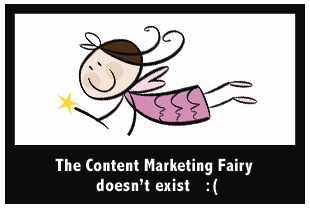We recently launched an ambitious content marketing initiative—for ourselves. As a marketing agency, we do similar projects for clients all the time. I figured that writing for ourselves, about subjects we knew so well, would be easier than the ghost-writing, prodding, and project management that goes into a typical client project.
I was wrong.
The Project
We came up with the following scope for Phase 1:
- 100 short "Q&A" articles
- 18 "medium" articles
- 3 "long" articles
- 3 interviews
Total: 124 articles over roughly 3 months.
That works out to about two articles per week for each full-time employee (all of whom are participating). This article was written as we started No. 30, and it was originally published as article No. 40.
Why We're Doing It
Content marketing is going to become an increasingly important component of virtually every company's overall marketing program. That includes us. So, we're launching our own content marketing to attract new clients.
But content marketing is also an increasingly important service we provide—one that requires an extraordinary amount of collaboration between agency and client. Clients create much (if not most) of the raw content in this process, so we thought it was important for the whole team to experience the content marketing process from the customer side.
We've found more than just specific techniques and tricks; we've found a tremendous amount of empathy and inspiration.
What We Got Right
1. Hold a solid kickoff meeting
A great kickoff meeting is central to any project. After two weeks of initial preparatory work, we gathered our entire team. In a four-hour session, we talked about the centrality of content marketing to our agency's future. We reviewed the overall scope and timeline, individual responsibilities, and resources that would be made available. Finally, we spent the last two hours answering questions, brainstorming topics, and discussing nuts and bolts.
2. Get team buy-in
Although I have great faith in my team, we are very busy. I was secretly anxious that I might face rebellion at the size of our undertaking (at one of the most demanding times of the year, no less). But there were no (audible) grumbles—just practical questions and solutions on how to make it work.
I think every team will step up to the plate when they understand the reasons behind the content marketing effort and they are given sufficient resources to get the job done.
3. Set an insanely ambitious editorial calendar
This might seem counterintuitive, but an ambitious calendar was one of the secrets of our success. Here's why:
- Internal projects usually take a back seat to client projects for most marketing and advertising agencies. We needed to achieve escape velocity before the pull of day-to-day projects sapped our will and strength. If you never slow down, you can't stop. And the massive dose of new habits inoculated us from any potential lethargy.
- People needed to find their voice. This was harder for some than others, but after three weeks of intense work, everyone began to discover what works for them. Intense practice over a short time period makes for a much shorter learning curve.
- Camaraderie. We all went through this intense process at the same time. We laughed. We cried. We typed. A lot. This was easily the best organizational bonding experience we've ever had.
What We Got Wrong
It wasn't all smooth sailing though. In the first 30 days, we screwed up a bunch of stuff. Here's what we learned from those mistakes:
1. Respect the editorial process
The first 30 articles ended up with a somewhat haphazard editorial process, and it shows. Some of the articles could be tighter, the headlines aren't great, there are stylistic quirks, and we need a stronger focus on specific publishing themes. Everyone benefits from a strong editor, and we're no exception.
2. Take workflow seriously
We're adamant about maintaining an airtight workflow for client projects, but for our own project, we somehow thought the content marketing fairy would take care of it for us.
We have some basic posting and tracking processes in place through a slapdash combination of Google spreadsheets, Dropbox, Wordpress, and email. A clear, refined workflow would help us work smarter and faster.
3. Write what you know, not what you were assigned
Some of our team took on assignments in which they didn't feel they were already experts, even though the topics were at least tangentially related to things they already did know very well. The research on these pieces was extremely time-consuming, and the articles themselves were the weakest we produced.
We realized that if you can't write 90% of the article without any research, you've picked the wrong topic. That is now our golden rule and our No. 1 takeaway after 30 days and 30 topics.
* * *
Those are just our Top 6 takeaways. The original article has all 15 lessons learned.




